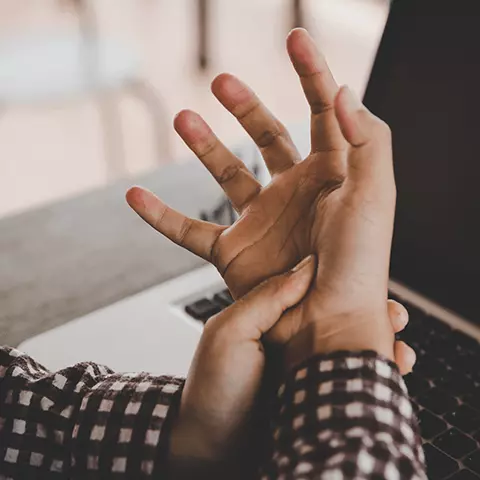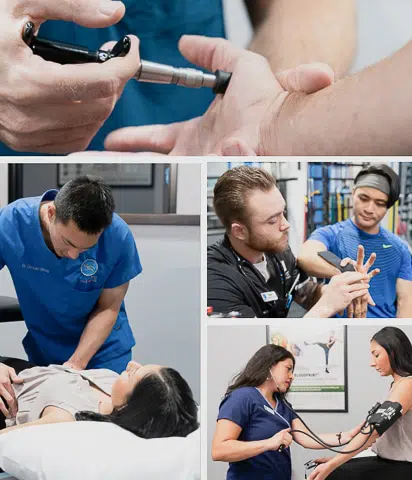Pins + Needles

Appointment Inquiries
Call us at: (877) 222-5348
Definition
A sensation of uncomforable tingling or prinking, usually felt in the arms, legs, hands or feet.
Root Causes
Bulging + Herniated Discs, Narrowing of the Nerve Canal, Neck Pain, Nerve Compression, Radiculopathy, Sciatica
Risk Factors
Abuse Alcohol, Age, Diabetes, Family History, Genetics, Infection, Kidney Diseases, Liver Diseases, Lupus, Neurological Disorders, Obesity, Repetitive Motion Injury, Rheumatoid Arthritis, Toxin Exposure, Vitamin Deficiency
Treatments
Chiropractic, Micronutrient Test, Nutritional Advice, Physical Therapy
What are ‘pins and needles?’
Pins and needles, also known as paresthesia, is the uncomfortable sensation of tingling, prickling, itching, or skin-crawling felt in your hands, arms, legs, or feet. You might know it or say that your foot/leg/hand/arm is “asleep.” This is paresthesia of the nervous system. It is a medical condition that can be temporary or long-term.
The most common cause for temporary (or acute) paresthesia is pressure on a nerve. This most often occurs when you are lying or sitting in an unnatural position and inadvertently compressing a nerve. Changing your position can quickly return normal feeling to the nerve and area around and below it as the nerve is decompressed.
Chronic (or long-term) paresthesia is usually caused by an underlying medical disorder that can require treatment. If your paresthesia is chronic, it may cause more than just pins and needles. You may also experience stabbing pain, clumsiness, and have difficulty walking or completing complex tasks with your hands or arms.
Symptoms of pins and needles
The pins and needles feeling most commonly occur in the:
- Arms
- Feet
- Hands
- Legs
Common symptoms of pins and needles include:
- Burning
- Cold
- Numbness
- Prickling and tingling sensation
- Weakness
Risk factors of pins and needles
Anyone can experience temporary paresthesia, but you may be at higher risk for temporary and chronic “pins and needles” with:
- Age, especially starting at 40
- Alcohol abuse
- Diabetes
- Family history
- Genetic disorders, such as Charcot-Marie-Tooth disease
- Infections, especially Lyme, shingles, Epstein-Barr, hepatitis B & C, and HIV
- Kidney diseases
- Liver diseases
- Lupus
- Neurological disorders, such as multiple sclerosis
- Obesity
- Repetitive motion, such as tennis/golfer elbow
- Rheumatoid arthritis
- Vitamin deficiency, especially vitamin B12 deficiency
- Toxin exposure
Causes of pins and needles
Temporary paresthesia is often due to short-term pressure on a nerve or a brief period of poor blood supply and circulation.
There are 2 main causes of paresthesia: radiculopathy and nerve damage.
Radiculopathy is a condition where the nerve becomes compressed, irritated, or inflamed. This most often occurs when you have:
- A herniated disc that presses on a nerve;
- A narrowing of the nerve canal;
- Any mass that has compressed the nerve as it exits the spinal column.
There are 2 major types of radiculopathy.
Lumbar radiculopathy, also known as sciatica or sciatic neuritis, affects your lower back. It can cause pins and needles and pain in your legs and/or feet. In the most severe cases, compression of the sciatic nerve may lead to pain and weaknesses in the glutes, legs, calves, and feet. It often affects only one side of the body, but it can affect both.
Cervical radiculopathy involves the nerves that provide sensation and strength to your arms and hands. It often presents as:
- Arm weakness
- Chronic neck pain
- Hand weakness
- Pins and needles in the arms and/or hands
It can also present as carpal tunnel syndrome.
The 3rd type of radiculopathy is thoracic. It’s less common, but usually presents as a band of pain around the chest and/or pins and needles in the abdomen, chest, or middle back.
While not always the case, chronic paresthesia may be a sign of nerve damage. The most common cause of nerve damage is diabetes.
Other causes of nerve damage include:
- Bone marrow or connective tissue disorders
- Certain medications
- High blood pressure
- Hypothyroidism
- Injury
- Stroke
- Trauma
- Tumors
While determining the underlying cause of paresthesia can be difficult, it can almost always be treated. If not treated, all types of paresthesia can lead to permanent damage causing permanent pins and needles, numbness, and paralysis if not treated early.
Diagnosis and treatment for pins and needles
Treatment depends on the diagnosis and level of severity of your paresthesia. If you have temporary paresthesia, it can often be relieved by normalizing how you sit, stand, walk, and sleep. If you are struggling to relieve it, physical therapy can help show you the best exercises, stretching, and body positions to release the pressure on the compressed nerves and blood vessels.
For chronic paresthesia, our doctors at BackFit Health + Spine will perform various tests to diagnose the type and severity of your paresthesia and discover the underlying cause. Family history and a physical examination will help, including discovering any atrophied muscles from the damage.
If there is not a conflicting underlying condition, the least invasive treatment is to free the affected nerve with chiropractic adjustments. Prescribed exercise with physical therapy can also help. Depending on the cause, we also recommend a blood test for deficiencies, nutritional testing, dietary advice, and supplementation. Bracing of the arm, leg, or back may also assist in recovery.
These non-invasive methods resolve most patients’ pins and needles and other peripheral pain. If your case is more advanced, we may refer you to our pain centers.
More About BackFit
Looking to learn more? Explore our locations, treatments, or our new patient offer below or contact one of the BackFit Family of staff to have your questions answered.


